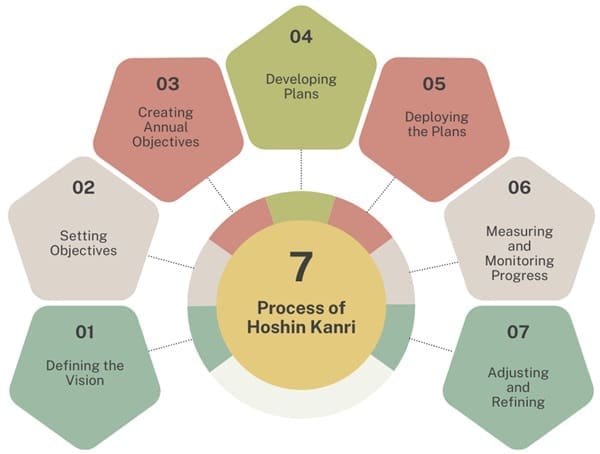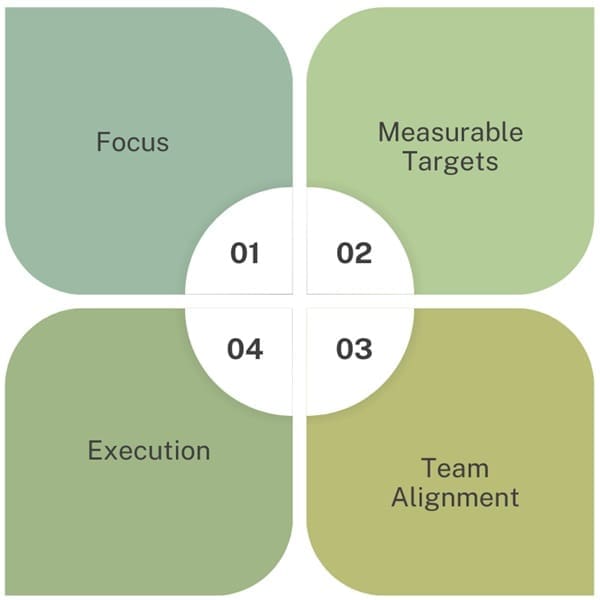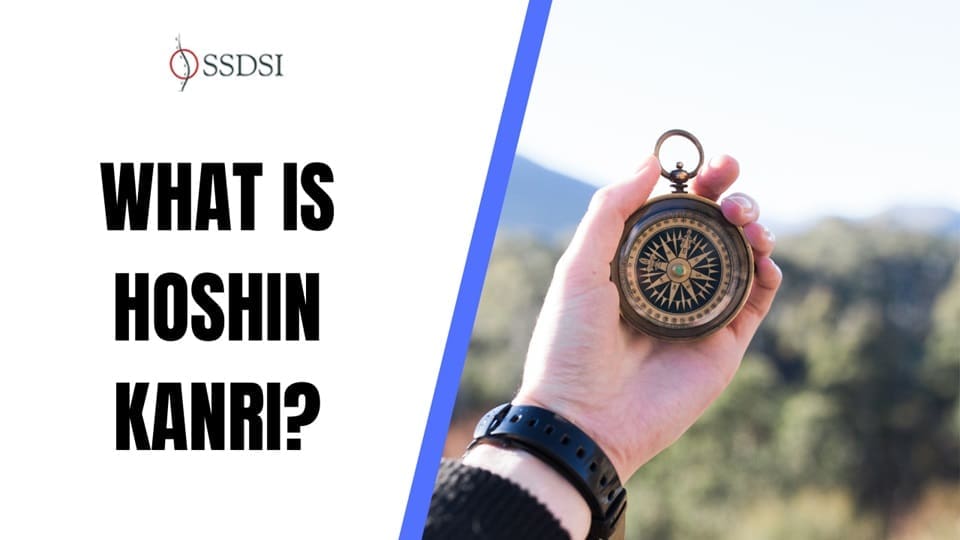Hoshin Kanri, often referred to as Hoshin Planning, is a strategic planning method originating from Japan that helps organizations align their goals, policies, and processes across all levels of management.
The term “Hoshin Kanri” comes from Japanese, with “Hoshin” meaning direction or compass and “Kanri” meaning management or control. It represents a system for setting and guiding strategic direction. Together, it helps organizations align their efforts with their long-term goals.
Table of contents
What is Hoshin Kanri?
Hoshin Kanri, also known as Hoshin Planning or Policy Deployment, is a strategic management methodology that helps organizations translate their long-term vision into actionable, measurable goals.
The approach structures the organization, aligning every level from senior management to the operational workforce with common objectives. This ensures that all employees work toward the same goals.
By promoting clarity in direction and focus, Hoshin Kanri fosters goal alignment and systematic execution across various departments.
The term itself comes from Japanese, where Hoshin means “shining needle” or “compass,” representing a guiding direction, and Kanri means “management” or “control.” Essentially, Hoshin Kanri is a tool used by organizations to navigate their way toward strategic goals.
Process of Hoshin Kanri

At the core of Hoshin Kanri is a continuous cycle of planning, execution, and evaluation. This process can be broken down into the following phases:
- Defining the Vision: The organization’s leadership starts by determining a long-term vision or strategic direction, which typically spans several years (often 3-5 years or more). This vision is ambitious and encourages breakthrough thinking about where the company should be in the future.
- Setting Objectives: Once the leadership sets the long-term vision, they break it down into specific goals, often called “breakthrough objectives.” They design these goals to push the organization toward substantial improvements. This approach drives significant progress and transformation.
- Creating Annual Objectives: Based on the breakthrough goals, annual objectives are developed. These shorter-term targets are more specific, measurable, and attainable within a year.
- Developing Plans: After establishing goals, concrete plans are crafted to ensure that the objectives can be met. Each plan contains details on the resources, actions, timelines, and individuals responsible for achieving the objectives.
- Deploying the Plans: This step involves communicating the plans throughout the organization. At every level, from top management down to the operational teams, employees must understand their roles and responsibilities in achieving the set goals.
- Measuring and Monitoring Progress: We create key performance indicators (KPIs) and other metrics to track progress toward the annual objectives. We conduct regular reviews and audits to ensure the organization stays on course. These measures help us maintain focus and achieve our goals.
- Adjusting and Refining: Based on the data collected from performance audits, organizations identify areas that need adjustment. If targets are not met, corrective actions are developed and implemented to improve performance.
Why is Hoshin Kanri Important?
Hoshin Kanri helps organizations maintain focus and alignment in a world where competing priorities can often dilute efforts. By ensuring that every part of an organization is working toward the same objectives, the approach enables the efficient use of resources and the coordinated achievement of goals. Hoshin Kanri emphasizes:
- Alignment: It ensures that everyone from senior leadership to individual employees understands the strategic direction of the company and how their work contributes to it.
- Focus: Organizations can achieve breakthrough results by focusing on a few critical priorities. This approach helps them avoid being spread too thin.
- Continuous Improvement: By regularly reviewing performance and making necessary adjustments, Hoshin Kanri fosters a culture of continuous improvement, which is critical for long-term success.
History of Hoshin Kanri
Hoshin Kanri originated in Japan during the post-World War II era, specifically in the 1950s and 1960s, as part of the Lean management movement.
Quality management practices strongly influenced the methodology. Companies seeking to improve operational efficiency and pursue strategic growth quickly adopted it. Prominent Japanese companies, such as Toyota, were early adopters, using Hoshin Kanri to achieve a high degree of coordination between their strategic vision and daily operations.
Over time, the method spread beyond Japan, particularly to the United States, where various industries, including manufacturing, healthcare, and technology adopted it. Some companies may refer to it under different names, such as Goal Deployment or Policy Deployment, but the underlying principles remain consistent.
How Does Hoshin Kanri Differ from Other Strategic Planning Methods?

Hoshin Kanri is one of several strategic planning methodologies. Some of the other popular frameworks include:
- Management by Objectives (MBO): Peter Drucker developed MBO, which involves setting clear, measurable goals for employees to work toward. We periodically review these goals to track progress. Hoshin Kanri is more structured than MBO. It emphasizes cross-departmental coordination and aligns short-term actions with long-term goals.
- OKRs (Objectives and Key Results): Popular in tech companies, OKRs focus on setting ambitious objectives and defining measurable outcomes to track progress. While OKRs are effective for setting high-level goals, Hoshin Kanri provides a more comprehensive framework that includes plan deployment and execution monitoring.
- OGSM (Objectives, Goals, Strategies, Metrics): Used in industries like retail and entertainment, OGSM provides a simplified model for goal setting and measurement. Hoshin Kanri, on the other hand, involves more detailed planning and a stronger emphasis on continuous improvement.
Five Phases of Hoshin Planning

Hoshin Kanri, or Hoshin Planning, is a strategic management method. It aligns an organization’s goals with its operational activities. This approach ensures that every employee, from top leadership to the shop floor, is working toward the same objectives, promoting organizational efficiency, and continuous improvement.
The method incorporates the principles of Total Quality Management (TQM). It structures itself into five key phases: Strategic Planning, Hoshin Deployment, Monitoring, Check and Act, and President’s Diagnosis.
Phase 1: Strategic Planning and Setting the Hoshin
The first phase of Hoshin Planning begins with the organization’s top leadership, typically the President or CEO, defining the company’s long-term vision. This vision sets the direction for the entire organization and is based on a deep understanding of both internal capabilities and external opportunities and threats.
The CEO must consider industry trends, competitive dynamics, and broader economic conditions to set a clear, forward-looking strategy.
In this phase, the leadership needs to ensure that the vision is not only aspirational but also achievable. To ensure a robust strategic plan, account for external factors such as market shifts, technological advancements, and potential obstacles. This consideration helps adapt and strengthen your strategy.
This phase lays the foundation for the rest of the process, as it provides the high-level objectives that will guide the company over a defined period.
Phase 2: Hoshin / Policy Deployment
Once the strategic vision is set, the next step is Hoshin Deployment. This step involves translating high-level objectives into actionable plans across all levels of the organization.
A key aspect of this phase is nemawashi, a Japanese term for informal consultation and consensus-building. Leaders at various levels engage in discussions to ensure alignment on how to implement the strategy before making formal decisions.
At this stage, senior executives assess the feasibility of the strategic vision set by the President. They determine how to break it down into specific goals, methods, measures, and timelines. The process repeats through all layers of management, from senior leadership to middle managers and frontline employees.
This approach ensures that the vision is communicated clearly. It also guarantees that everyone across the organization understands it.
A crucial tool used in this phase is “Catchball.” This process involves back-and-forth communication where different management levels exchange ideas to refine and adjust the plan. Catchball ensures alignment at every level of the company and facilitates the smooth execution of strategic goals.
It allows for negotiation and refinement of the vision, making the deployment process more collaborative and inclusive.
Phase 3: Monitoring the Hoshin – Controlling with Metrics
After deploying the strategic plan, the organization must monitor its progress against set targets. The company establishes metrics in Phase 3 to track performance. It reviews these metrics monthly and compares actual results with defined goals. If discrepancies arise, adjustments are made in real time to keep the company on course.
This phase highlights the need for continuous monitoring and timely realignment. Metrics act as objective indicators of progress, and regular reviews help identify and address issues early. This proactive approach reduces the risk of deviating from the strategic plan and maintains momentum toward achieving the company’s long-term goals.
Phase 4: Check and Act
The fourth phase focuses on evaluating the effectiveness of the Hoshin process. Leaders monitor the progress made and assess whether the strategy and execution are delivering the desired outcomes. This phase also involves reflecting on the lessons learned during the implementation process.
Leaders identify shortcomings or areas for improvement. They recommend changes to the Hoshin process. The goal is to foster a culture of continuous improvement. Feedback loops integrate into the strategic management process.
By regularly reviewing both the outcomes and the procedures, the organization ensures that it can adapt to any unforeseen challenges or changes in the business environment.
Phase 5: President’s Diagnosis
The final phase of the Hoshin Planning process is the President’s Diagnosis. In this phase, the top leadership, usually the President or CEO, consults with various business units and divisions to assess the overall performance and outcomes driven by the Hoshin plan. This review helps the leadership understand the strategy’s effectiveness. It also shows whether they need to adjust it for future use.
Based on the insights gained, the President can make necessary adjustments to the Hoshin process, ensuring that it remains relevant and effective in addressing the organization’s needs. This phase ensures that the strategic planning process remains dynamic and responsive to changes, fostering long-term success.
Why Hoshin Kanri?
Hoshin Kanri is essential because it bridges the gap between high-level strategic planning and day-to-day operational activities. It ensures that every department and individual aligns with the company’s long-term vision. It also ensures that they align with the company’s goals.
The method encourages a structured approach to achieving continuous improvement and enhancing operational efficiency.
This strategic planning framework was pioneered by Yoji Akao in Japan during the 1960s. Akao emphasized the need for a method that connects an organization’s strategic objectives with its production and operational functions.
Hoshin Kanri has since become a cornerstone of Total Quality Management (TQM) in many industries, helping organizations align their policies with quality improvement initiatives.
In the ever-evolving business environment, traditional methods of strategic planning often fall short in addressing complex, dynamic problems. Hoshin Kanri addresses this challenge by creating a flexible, responsive planning process that adapts to new information and insights.
Unlike other methods that focus on solving predefined problems, Hoshin Kanri encourages organizations to continuously redefine problems and solutions based on real-time feedback.
The method’s structured approach provides a clear pathway for organizations to translate their long-term goals into concrete actions.
By involving employees at every level, Hoshin Kanri fosters a sense of ownership and accountability, motivating them to contribute to the organization’s success.
This top-down and bottom-up planning approach ensures that strategies are both realistic and aligned with the company’s capabilities and resources.
Principles of Hoshin Kanri
Hoshin Kanri operates on a few core principles that distinguish it from other management methodologies:

- Alignment Across the Organization: Top leadership sets common goals. Every department and individual within the company must align with these goals.
- Responsibility and Accountability: Every team is responsible for reviewing and improving the Hoshin process. It ensures that corrective actions are taken when necessary.
- Understanding of TQM and PDCA: Hoshin Kanri integrates Total Quality Management (TQM) principles and follows the PDCA (Plan-Do-Check-Act) cycle.
- Catchball Communication: The negotiation process spans different levels. It ensures that all stakeholders align with the strategy.
- Focus on Key Priorities: Hoshin Kanri emphasizes focusing on a small number of key goals that are critical for the organization’s success.
- Continuous Improvement: The method fosters a culture of ongoing improvement and flexibility, where the organization continuously adapts to new challenges.
- Customer-Centric Goals: Customer needs drive the objectives. This ensures that the organization remains competitive and responsive to market demands.
- Process-Focused Approach: Hoshin Kanri focuses on improving processes rather than merely achieving results. Better processes lead to better outcomes.
- Rigorous Analysis: Each stage of the process is thoroughly reviewed to ensure that strategies are effective.
- Top-Down and Bottom-Up Planning: The method encourages both high-level strategic planning and input from frontline employees to ensure practical implementation.
Seven Steps of Hoshin Kanri
The Hoshin Kanri process can be broken down into seven key steps:
- Establish Organizational Vision: Define where the organization wants to be in the long term.
- Develop Breakthrough Objectives: Set ambitious goals that, if achieved, would represent significant progress toward the vision.
- Develop Annual Objectives: Break down the breakthrough objectives into achievable goals for the year.
- Deploy Annual Objectives: Communicate the objectives across the organization. Ensure that all levels are aligned.
- Implement Annual Objectives: Start executing the plans. These plans were developed to achieve the annual objectives.
- Monthly Reviews: Track progress using the defined metrics and make necessary adjustments based on performance data.
- Annual Review: At the end of the year, review overall performance and adjust the long-term vision and breakthrough objectives as needed.
Is Hoshin Kanri Right for Your Organization?
Hoshin Kanri is versatile and can be applied across different sectors and organizations of all sizes. Whether you’re a small company looking to improve focus or a large multinational corporation striving for better coordination, Hoshin Kanri offers a structured way to align strategic priorities with day-to-day activities.
However, implementing Hoshin Kanri does require a shift in mindset and organizational culture.

Some factors to consider include:
- Focus: If your organization struggles to maintain focus on a few key priorities, Hoshin Kanri can help narrow your strategic options and direct resources toward high-impact goals.
- Measurable Targets: If you find it challenging to set clear, measurable goals, the framework of Hoshin Kanri offers a structured approach to developing meaningful performance metrics.
- Team Alignment: If alignment across departments is an issue, Hoshin Kanri’s catch-ball process can help by encouraging cross-functional communication and collaboration.
- Execution: If your organization struggles with follow-through after setting plans, the Plan-Do-Check-Act (PDCA) cycle embedded in Hoshin Kanri can foster a culture of continuous improvement.
Challenges of Implementing Hoshin Kanri
Like any organizational change, implementing Hoshin Kanri is not without its challenges. Some of the most common hurdles include:
- Resistance to Accountability: Some individuals, especially at senior levels, may resist the idea of being held to specific targets. Overcoming this resistance requires strong leadership and buy-in from all levels of the organization.
- Cultural Barriers: For Hoshin Kanri to work, organizations must embrace a culture of learning and continuous improvement. Failure is seen as an opportunity to learn, not a reason for punishment. This requires a shift in how many organizations handle unmet goals.
- Data Issues: Accurate, real-time data is crucial for measuring progress and making informed decisions. Organizations with inconsistent or incorrect data systems may struggle to implement Hoshin Kanri effectively.
Final Words
Hoshin Kanri is a powerful tool for organizations looking to translate their strategic vision into practical, measurable actions. By focusing on alignment, structured planning, and continuous improvement, it ensures that every level of an organization is working toward the same goals.
While challenges in implementation may arise, particularly around accountability and cultural shifts, the potential benefits make it a highly valuable methodology for organizations across industries.
Whether you’re in manufacturing, technology, healthcare, or any other sector, Hoshin Kanri can help drive meaningful, breakthrough improvements for your organization.

About Six Sigma Development Solutions, Inc.
Six Sigma Development Solutions, Inc. offers onsite, public, and virtual Lean Six Sigma certification training. We are an Accredited Training Organization by the IASSC (International Association of Six Sigma Certification). We offer Lean Six Sigma Green Belt, Black Belt, and Yellow Belt, as well as LEAN certifications.
Book a Call and Let us know how we can help meet your training needs.



















